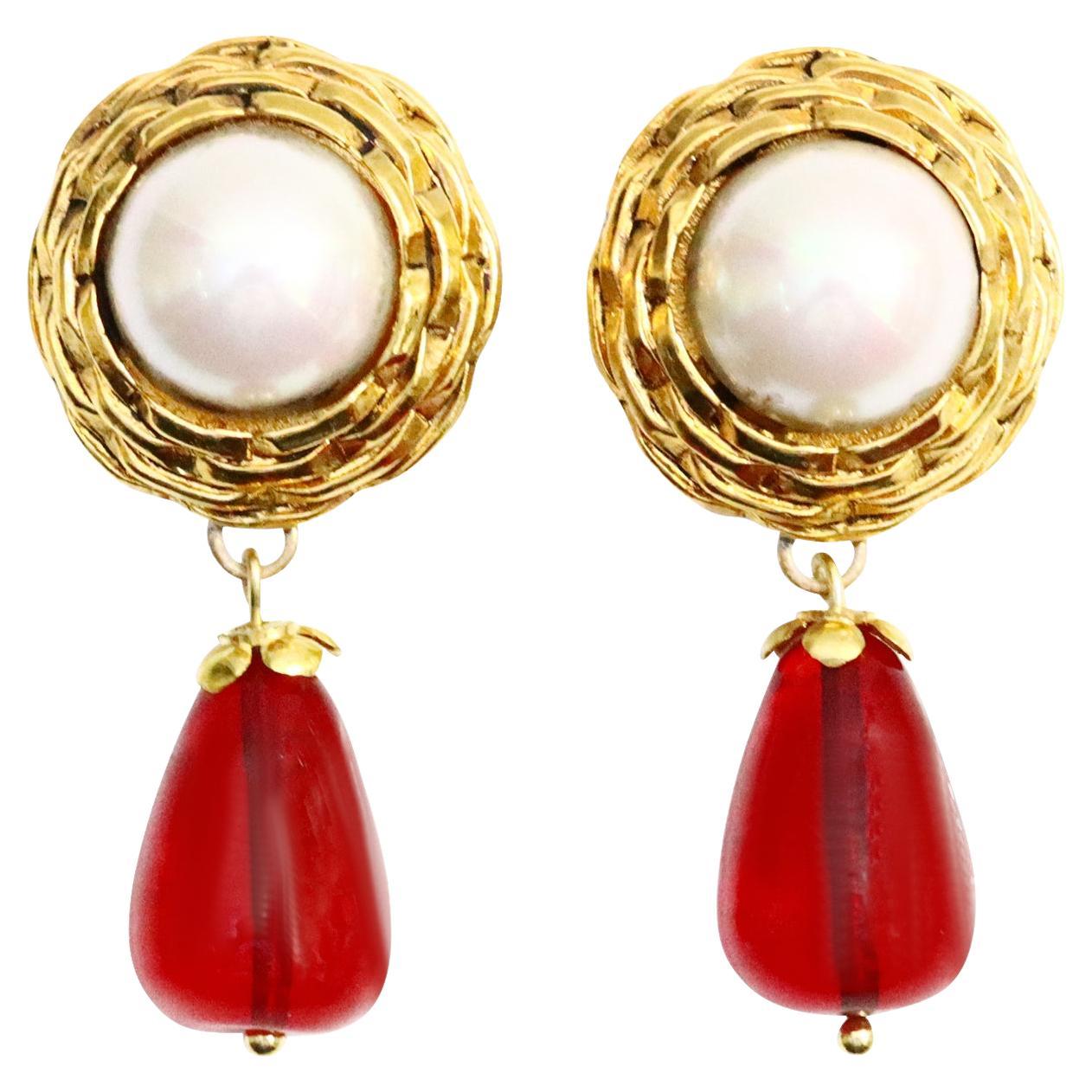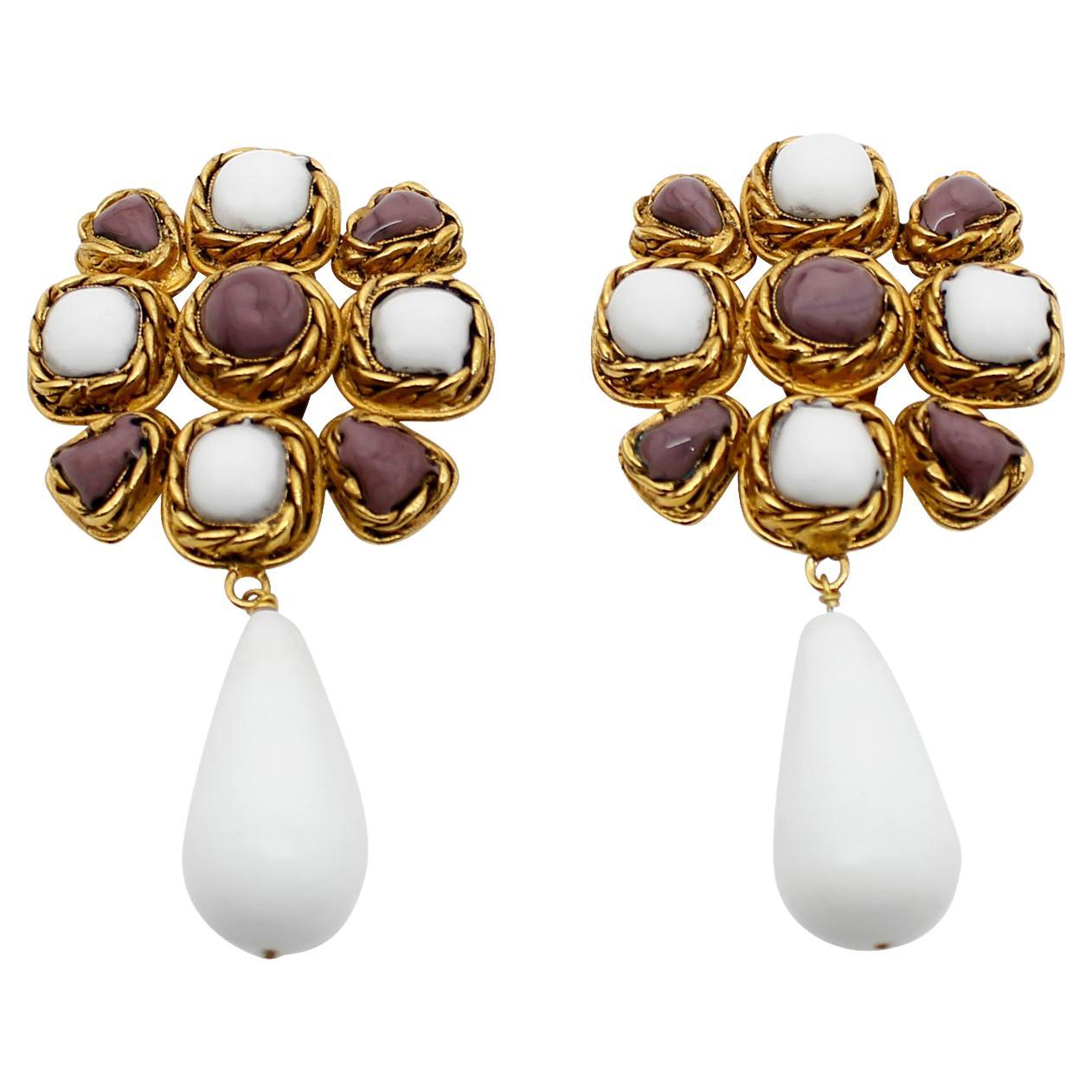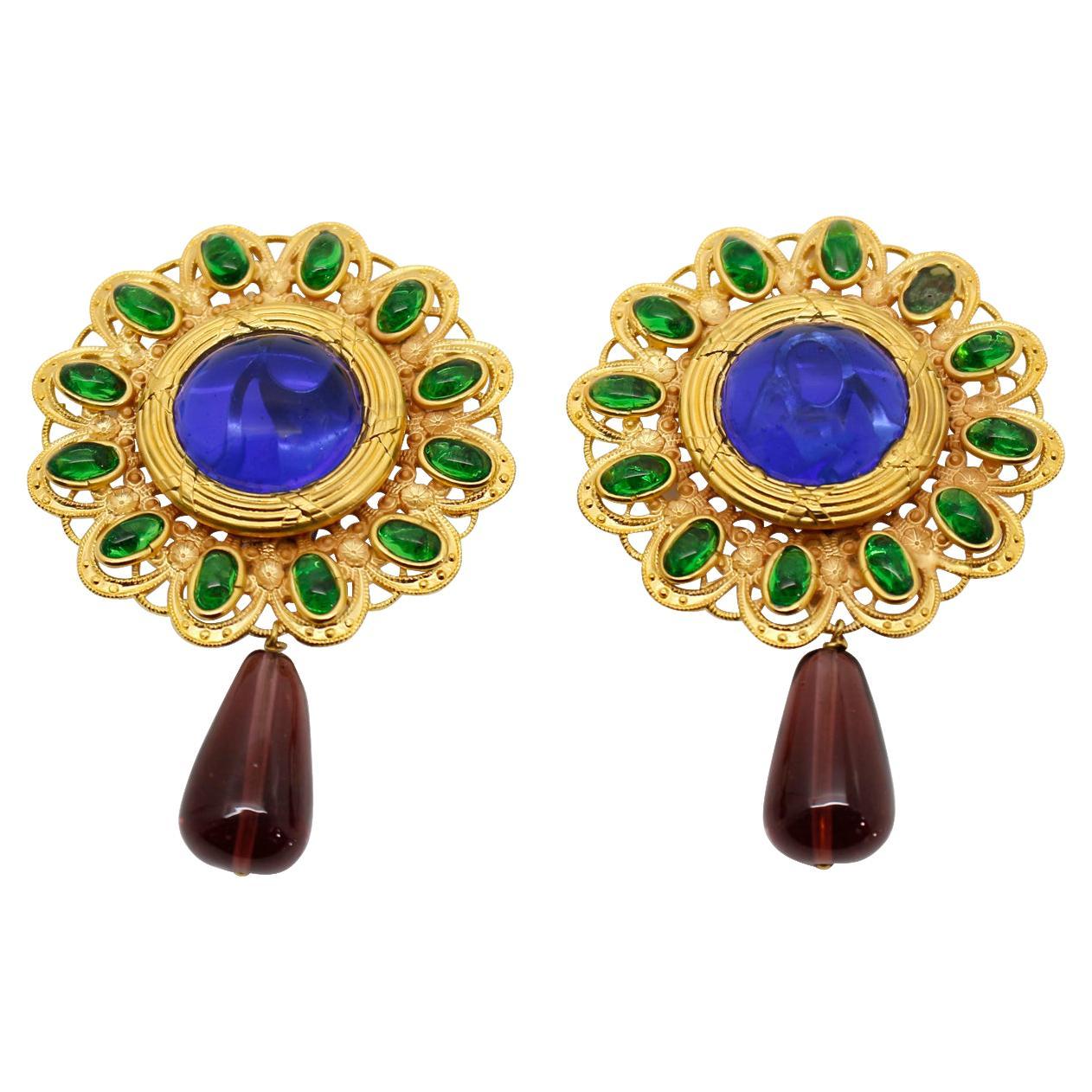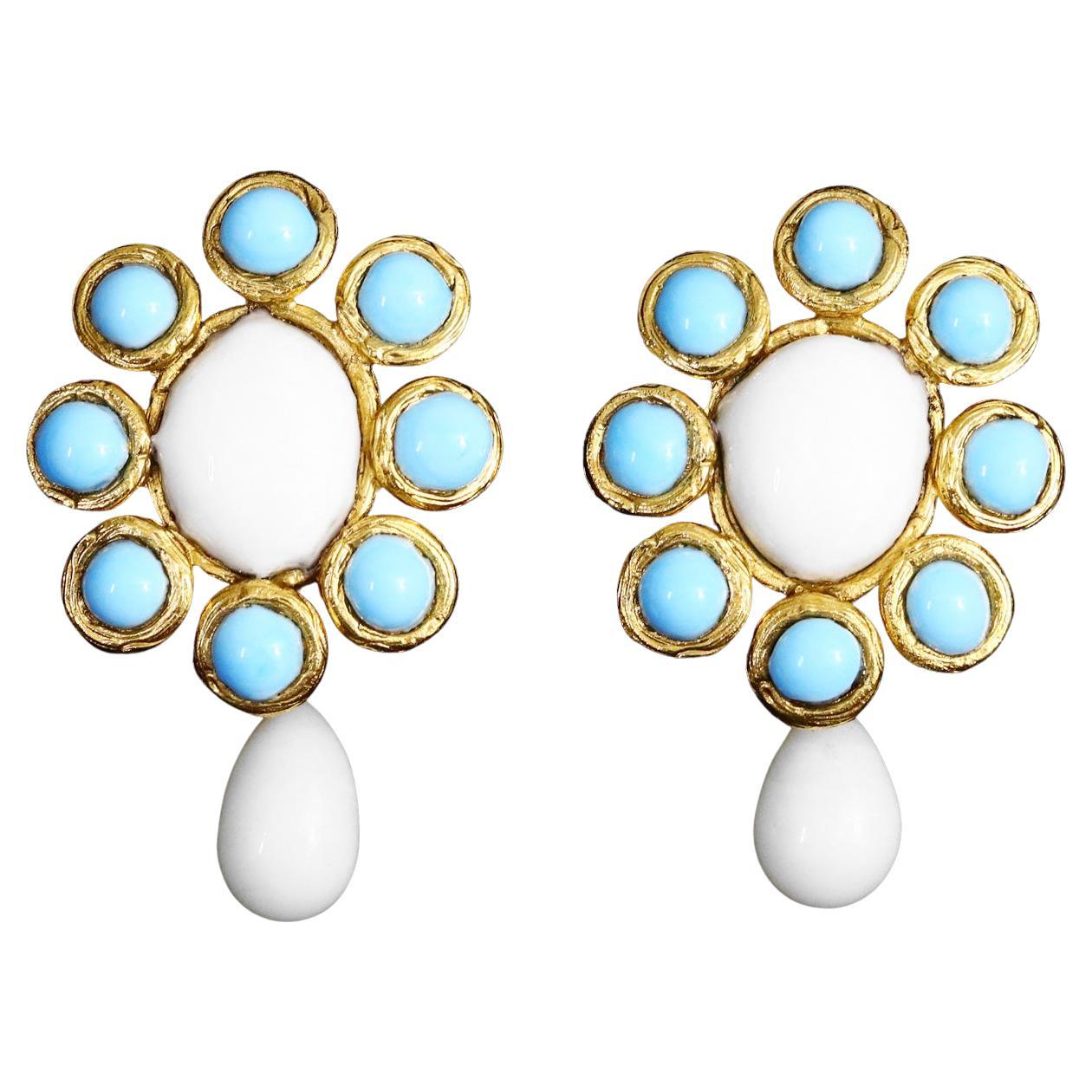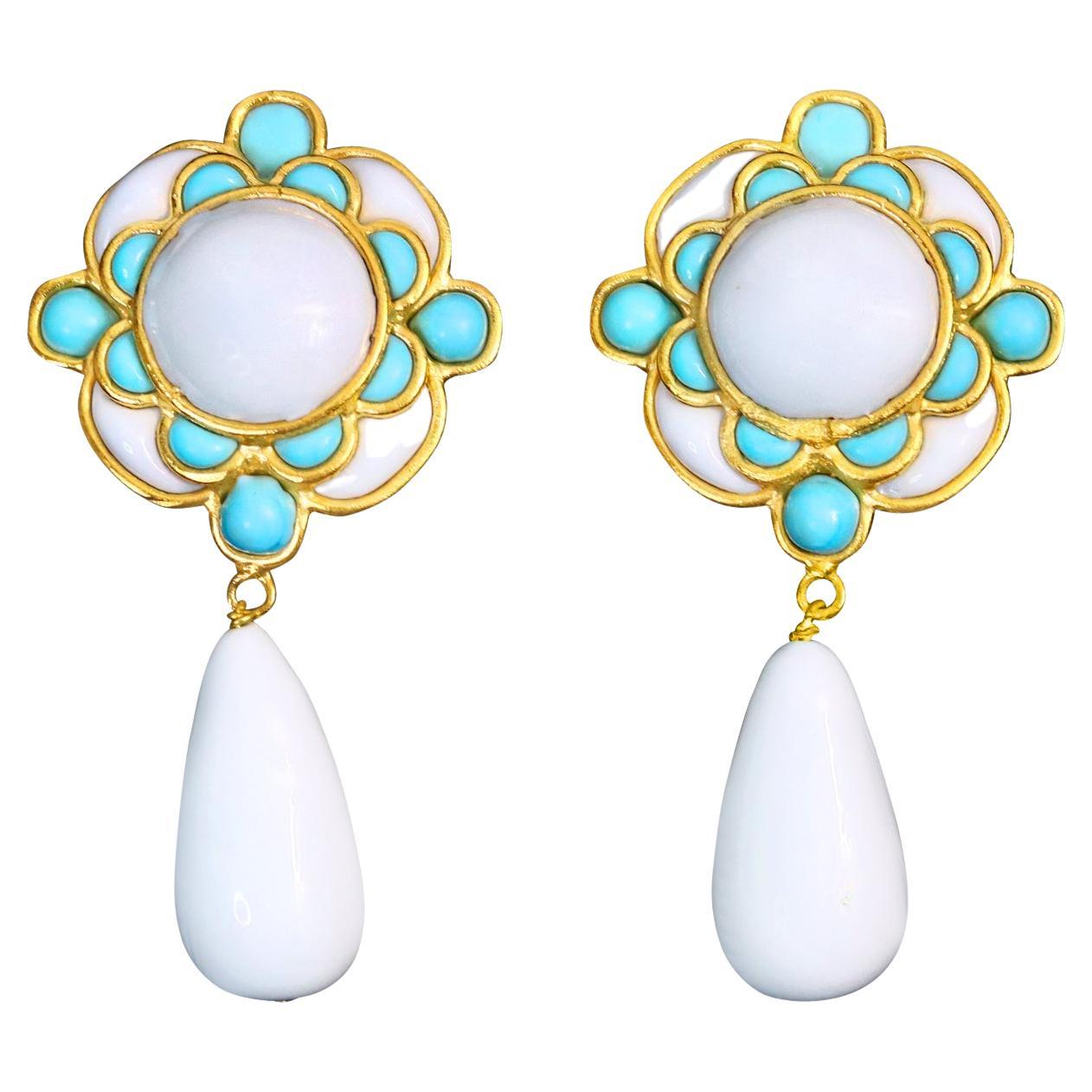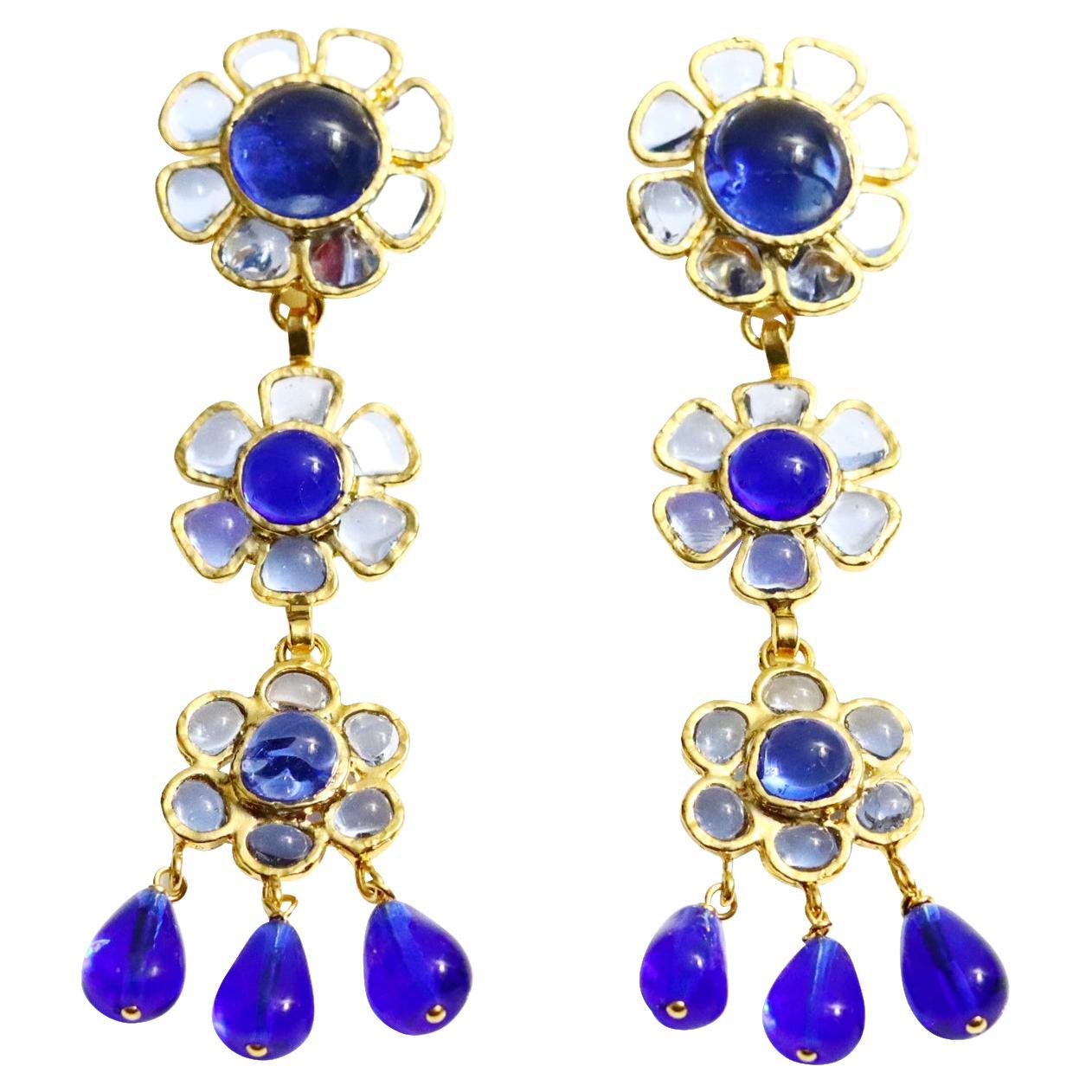Items Similar to Maison Gripoix Vintage Red and Green Flower Dangling Earrings Circa 1980s
Video Loading
Want more images or videos?
Request additional images or videos from the seller
1 of 9
Maison Gripoix Vintage Red and Green Flower Dangling Earrings Circa 1980s
About the Item
Maison Gripoix Vintage Red and Green Flower Dangling Earrings Set in Gold Tone. These are some of the most gorgeous earrings I have in the collection. The colors of course and the way they are made. They are just special. They will always be relevant. They are well made and make a statement. They are just classy and chic. Clip On. Always In Style. Clip on.
I also have them in blue. They are slightly less in price due to exchange rate at time of purchase. Acquired in Paris.
Guy de Maupassant wrote a famous story about a necklace. The story is about a young, pretty, intelligent, well educated but poorly endowed bride who has to marry a petty official; and thus suffering from the limitations of living a life with a husband that lacked any exquisite qualities. In order to entertain his dejected spouse, one day her husband gets an invitation to a ball and gives his wife 400 francs he had saved for a hunting rifle so that she would be able to order an appropriate dress.
However, when the dress is ready it becomes clear that it is lacking jewelry; and it would be impossible to attend the ball while looking so poor. The protagonist approaches her rich childhood friend with whom she was raised together at the monastery and borrows a diamond necklace from her. The ball is a great success and she is the centre of attention. However when the woman returns home, she discovers that she has lost the necklace. In order to conceal her faux pas from her friend, she buys a new necklace identical to the one she lost, and to pay it off the woman gets into a huge debt which over the years gradually drags her down the social ladder from bourgeoisie to poverty. Ten years later, having lost her good looks, the woman encounters her friend on the Champs Elysees, who still looks young, beautiful and rich. The protagonist reveals to her friend the whole story about the necklace, but her friend replies in amazement that the diamonds were fake and would “cost 500 francs at most”.
Maison Gripoix starts out with a dramatic story. In 1869 (or a year earlier, according to other sources), Paris master glass-maker Augustina Gripoix began making replicas of pearls and crystals; casting glass into different shapes and colours and inserting them into most sophisticated settings. She used the pâte de verre (glass paste) technique, whereby a traditional ceramic or qypsum form was filled with a multi-colour pieces of glass and special gluing substances and then baked in a furnace, resulting in objects featuring fantastical hues. Only Augustina made her crystals by pouring the melted glass paste into the press moulds skipping the furnace step, allowing her to achieve the purity of colour, transparency and shine. She found a simple method to make beautiful jewelry and thus Marquises, Duchesses and Princesses qued up ... so Madame Gripoix would make them replicas of their own jewelry in case of robbery or loss, or some unusual jewelry pieces for their new wraps, neckpieces, or boas. The so-called ‘costume jewelry’ emerged to a large extent thanks to the work of Maison Gripoix.
Augustina Gripoix earned her fame in the 1890’s when she started making necklaces for Sarah Bernhardt to wear on stage; and later the costume jewelry for the first high fashion house of Charles Frederick Worth. Later on, Paul Poiret, the leading couturier of the 1910’s contacted her and she created sophisticated oriental style jewelry for him to match his famous oriental costumes based on the aesthetic of Diaghilev’s initial Russian seasons.
The value of costume jewelry was now being recognized in its own right; and not just for imitation purposes. The taste of emancipated young girls, who were gaining more and more freedom and opportunities, was best met with bijouterie. So in the 1920, when Augustina’s daughter Susan became the head of the House; Gripoix prospects became even more exciting. Girls with short-cropped hair in short dresses zoomed by in open-top cars wearing bijou rather than diamonds. Everyone ordered bijouterie from Madam Gripoix during this period, from Jeanne Lanvin to Jean Piguet, but certainly the best relationship Gripoix had was with Gabriel Chanel.
It is well-known that Chanel, a fan of large jewelry with large stones, made bijouterie super fashionable. Chanel brought copies of byzantine jewelry to Susanne Gripoix; and asked her to make the pieces in that same style, requesting: “Let everyone think that this jewelry is not new, but found somewhere on an excavation site nearby Rue Camborne”. She was so satisfied with the result of her order that she remained a faithful client of Gripoix for several decades. This was how the famous byzantine style of Chanel jewelry was brought to life, fancying golden Maltese crosses with large multicolor stones and matching bracelets; cabochons and massive brooches all of which have become a part of the Gripoix
Chanel liked to combine both natural and imitation stones in one item, for example she would combine natural and imitation pearls in one necklace. Gripoix made them in such a way that it was impossible to tell the difference between the either of them. Susanne Gripoix made special irregular shape pearls from glass for Chanel; imitating the baroque pearls. They were enameled in her workshops with mother-of-pearl to obtain some of the soft shine characteristic of natural pearls
.
As the main Paris supplier to the couturier houses, Gripoix worked for many designers: from Cristobal Balenciaga, Pierre Balmain and Christian Dior to Yves Saint Laurent; and later for Christian Lacroix and Marc Jacobs. However it was the cooperation with Chanel that was the most significant, both for Chanel and for Gripoix.
Today Gripoix is no longer a family affair/company but the House still makes jewelry, although the style has changed considerably over the last few years. The jewelry has become simpler, more graphical and even minimalistic. In 2011, however, Gripoix and Catherine Baba, a well-known Paris stylist and the star of street-style blogs, released a joint collection in the style of Art Nouveau and neo-romanticism. Even today, Gripoix tries to preserve the traditional techniques of moulding and enameling. They use a special copper alloy supplied by the Art Metal Company that is as old as Gripoix, and the formula of this alloy is kept secret. After it's melted, dragged and screwed in various ways, it is made into moulds that are welded using brass powder, a technique rarely found elsewhere today, before being gold-plated in the neighbouring workshop. Historical jewelry made by Gripoix, especially pieces made for Chanel, are the objects of real cult value. They are collected, they are hunted down, they are sold at auction, and their prices have recently sky-rocketed.
- Creator:
- Metal:
- Weight:32.8 g
- Dimensions:Height: 3.75 in (95.25 mm)Width: 1 in (25.4 mm)Depth: 0.25 in (6.35 mm)Diameter: 1 in (25.4 mm)Length: 3.75 in (95.25 mm)
- Style:
- Place of Origin:
- Period:
- Date of Manufacture:1980
- Condition:Wear consistent with age and use. Excellent Condition!
- Seller Location:New York, NY
- Reference Number:
About the Seller
5.0
Recognized Seller
These prestigious sellers are industry leaders and represent the highest echelon for item quality and design.
Platinum Seller
These expertly vetted sellers are 1stDibs' most experienced sellers and are rated highest by our customers.
Established in 2014
1stDibs seller since 2022
123 sales on 1stDibs
Typical response time: <1 hour
- ShippingRetrieving quote...Ships From: New York, NY
- Return PolicyA return for this item may be initiated within 1 day of delivery.
More From This SellerView All
- Maison Gripoix Vintage Faux Pearl and Red Dangling Earrings Circa 1980sBy Maison GripoixLocated in New York, NYMaison Gripoix Vintage Faux Pearl and Red Dangling Earrings. Wrapped in woven gold around the Pearl in the typical 1980s style of Chanel. Clip on. So classic and you always look good no matter what you are wearing when you have these on. Clip on. Very much the colors of Chanel. Guy de Maupassant wrote a famous story about a necklace. The story is about a young, pretty, intelligent, well educated but poorly endowed bride who has to marry a petty official; and thus suffering from the limitations of living a life with a husband that lacked any exquisite qualities. In order to entertain his dejected spouse, one day her husband gets an invitation to a ball and gives his wife 400 francs he had saved for a hunting rifle so that she would be able to order an appropriate dress. However, when the dress is ready it becomes clear that it is lacking jewelry; and it would be impossible to attend the ball while looking so poor. The protagonist approaches her rich childhood friend with whom she was raised together at the monastery and borrows a diamond necklace from her. The ball is a great success and she is the centre of attention. However when the woman returns home, she discovers that she has lost the necklace. In order to conceal her faux pas from her friend, she buys a new necklace identical to the one she lost, and to pay it off the woman gets into a huge debt which over the years gradually drags her down the social ladder from bourgeoisie to poverty. Ten years later, having lost her good looks, the woman encounters her friend on the Champs Elysees, who still looks young, beautiful and rich. The protagonist reveals to her friend the whole story about the necklace, but her friend replies in amazement that the diamonds were fake and would “cost 500 francs at most”. Maison Gripoix starts out with a dramatic story. In 1869 (or a year earlier, according to other sources), Paris master glass-maker Augustina Gripoix began making replicas of pearls and crystals; casting glass into different shapes and colours and inserting them into most sophisticated settings. She used the pâte de verre (glass paste) technique, whereby a traditional ceramic or qypsum form was filled with a multi-colour pieces of glass and special gluing substances and then baked in a furnace, resulting in objects featuring fantastical hues. Only Augustina made her crystals by pouring the melted glass paste into the press moulds skipping the furnace step, allowing her to achieve the purity of colour, transparency and shine. She found a simple method to make beautiful jewelry and thus Marquises, Duchesses and Princesses qued up ... so Madame Gripoix would make them replicas of their own jewelry in case of robbery or loss, or some unusual jewelry pieces for their new wraps, neckpieces, or boas. The so-called ‘costume jewelry’ emerged to a large extent thanks to the work of Maison Gripoix. Augustina Gripoix earned her fame in the 1890’s when she started making necklaces for Sarah Bernhardt to wear on stage; and later the costume jewelry for the first high fashion house of Charles Frederick Worth. Later on, Paul Poiret, the leading couturier of the 1910’s contacted her and she created sophisticated oriental style jewelry for him to match his famous oriental costumes based on the aesthetic of Diaghilev’s initial Russian seasons. The value of costume jewelry was now being recognized in its own right; and not just for imitation purposes. The taste of emancipated young girls, who were gaining more and more freedom and opportunities, was best met with bijouterie. So in the 1920, when Augustina’s daughter Susan became the head of the House; Gripoix prospects became even more exciting. Girls with short-cropped hair in short dresses zoomed by in open-top cars wearing bijou rather than diamonds. Everyone ordered bijouterie from Madam Gripoix during this period, from Jeanne Lanvin to Jean Piguet...Category
Vintage 1980s French Artist Drop Earrings
MaterialsMixed Metal
- Maison Gripoix Vintage White and Purple Dangling Earrings Circa 1980sBy Maison GripoixLocated in New York, NYMaison Gripoix Vintage White and Light Purple Dangling Earrings. These will always be in style. The Chanel look has never left. It is classic and timeless and says class. It is an elevated look. No matter what you wear these will look right. A Chanel suit or jeans and a white t shirt with a blazer. You look stunning and done. These are all you need. Clip on. This look will always walk down the Chanel runway in one form or another. I will send you velcro dots to hold them on and you can do cartwheels in these earrings. The models in Paris wear them and you can easily go 20 hours. Just remind me. Guy de Maupassant wrote a famous story about a necklace. The story is about a young, pretty, intelligent, well educated but poorly endowed bride who has to marry a petty official; and thus suffering from the limitations of living a life with a husband that lacked any exquisite qualities. In order to entertain his dejected spouse, one day her husband gets an invitation to a ball and gives his wife 400 francs he had saved for a hunting rifle so that she would be able to order an appropriate dress. However, when the dress is ready it becomes clear that it is lacking jewelry; and it would be impossible to attend the ball while looking so poor. The protagonist approaches her rich childhood friend with whom she was raised together at the monastery and borrows a diamond necklace from her. The ball is a great success and she is the centre of attention. However when the woman returns home, she discovers that she has lost the necklace. In order to conceal her faux pas from her friend, she buys a new necklace identical to the one she lost, and to pay it off the woman gets into a huge debt which over the years gradually drags her down the social ladder from bourgeoisie to poverty. Ten years later, having lost her good looks, the woman encounters her friend on the Champs Elysees, who still looks young, beautiful and rich. The protagonist reveals to her friend the whole story about the necklace, but her friend replies in amazement that the diamonds were fake and would “cost 500 francs at most”. Maison Gripoix starts out with a dramatic story. In 1869 (or a year earlier, according to other sources), Paris master glass-maker Augustina Gripoix began making replicas of pearls and crystals; casting glass into different shapes and colours and inserting them into most sophisticated settings. She used the pâte de verre (glass paste) technique, whereby a traditional ceramic or qypsum form was filled with a multi-colour pieces of glass and special gluing substances and then baked in a furnace, resulting in objects featuring fantastical hues. Only Augustina made her crystals by pouring the melted glass paste into the press moulds skipping the furnace step, allowing her to achieve the purity of colour, transparency and shine. She found a simple method to make beautiful jewelry and thus Marquises, Duchesses and Princesses qued up ... so Madame Gripoix would make them replicas of their own jewelry in case of robbery or loss, or some unusual jewelry pieces for their new wraps, neckpieces, or boas. The so-called ‘costume jewelry’ emerged to a large extent thanks to the work of Maison Gripoix. Augustina Gripoix earned her fame in the 1890’s when she started making necklaces for Sarah Bernhardt to wear on stage; and later the costume jewelry for the first high fashion house of Charles Frederick Worth. Later on, Paul Poiret, the leading couturier of the 1910’s contacted her and she created sophisticated oriental style jewelry for him to match his famous oriental costumes based on the aesthetic of Diaghilev’s initial Russian seasons. The value of costume jewelry was now being recognized in its own right; and not just for imitation purposes. The taste of emancipated young girls, who were gaining more and more freedom and opportunities, was best met with bijouterie. So in the 1920, when Augustina’s daughter Susan became the head of the House; Gripoix prospects became even more exciting. Girls with short-cropped hair in short dresses zoomed by in open-top cars wearing bijou rather than diamonds. Everyone ordered bijouterie from Madam Gripoix during this period, from Jeanne Lanvin to Jean Piguet, but certainly the best relationship Gripoix had was with Gabriel Chanel. It is well-known that Chanel, a fan of large jewelry with large stones, made bijouterie super fashionable. Chanel brought copies of byzantine jewelry to Susanne Gripoix; and asked her to make the pieces in that same style, requesting: “Let everyone think that this jewelry is not new, but found somewhere on an excavation site nearby Rue Camborne”. She was so satisfied with the result of her order that she remained a faithful client of Gripoix for several decades. This was how the famous byzantine style of Chanel jewelry was brought to life, fancying golden Maltese crosses with large multicolor stones and matching bracelets; cabochons and massive brooches all of which have become a part of the Gripoix Chanel liked to combine both natural and imitation stones in one item, for example she would combine natural and imitation pearls in one necklace. Gripoix made them in such a way that it was impossible to tell the difference between the either of them. Susanne Gripoix made special irregular shape pearls from glass for Chanel; imitating the baroque pearls. They were enameled in her workshops with mother-of-pearl to obtain some of the soft shine characteristic of natural pearls . As the main Paris supplier to the couturier houses, Gripoix worked for many designers: from Cristobal Balenciaga, Pierre Balmain and Christian Dior to Yves Saint Laurent; and later for Christian Lacroix and Marc Jacobs. However it was the cooperation with Chanel that was the most significant, both for Chanel and for Gripoix. Today Gripoix is no longer a family affair/company but the House still makes jewelry, although the style has changed considerably over the last few years. The jewelry has become simpler, more graphical and even minimalistic. In 2011, however, Gripoix and Catherine Baba...Category
Vintage 1980s French Artist Drop Earrings
MaterialsMixed Metal
- Maison Gripoix Vintage Blue, Green and Red Dangling Earrings Circa 1980sBy Maison GripoixLocated in New York, NYMaison Gripoix Vintage Blue, Green and Red Dangling Earrings. These will always look classic and in style. This look never leaves the mood board. ...Category
Vintage 1980s French Artist Dangle Earrings
MaterialsMixed Metal
- Vintage Maison Gripoix Faux Turquoise and White Dangling Earrings Circa 1980sBy Maison GripoixLocated in New York, NYMaison Gripoix Vintage Faux Turquoise and White Layered Dangling Earrings. There are three layers to this all wrapped around with an offset gold tone and then a long dangling piece. These are so stunning and look good with many colors. Clip On. These are true statement earrings in that they are so well made and one knows it is a special piece and not an off the rack piece. These can also be worn in the winter against dark colors. Guy de Maupassant wrote a famous story about a necklace. The story is about a young, pretty, intelligent, well educated but poorly endowed bride who has to marry a petty official; and thus suffering from the limitations of living a life with a husband that lacked any exquisite qualities. In order to entertain his dejected spouse, one day her husband gets an invitation to a ball and gives his wife 400 francs he had saved for a hunting rifle so that she would be able to order an appropriate dress. However, when the dress is ready it becomes clear that it is lacking jewelry; and it would be impossible to attend the ball while looking so poor. The protagonist approaches her rich childhood friend with whom she was raised together at the monastery and borrows a diamond necklace from her. The ball is a great success and she is the centre of attention. However when the woman returns home, she discovers that she has lost the necklace. In order to conceal her faux pas from her friend, she buys a new necklace identical to the one she lost, and to pay it off the woman gets into a huge debt which over the years gradually drags her down the social ladder from bourgeoisie to poverty. Ten years later, having lost her good looks, the woman encounters her friend on the Champs Elysees, who still looks young, beautiful and rich. The protagonist reveals to her friend the whole story about the necklace, but her friend replies in amazement that the diamonds were fake and would “cost 500 francs at most”. Maison Gripoix starts out with a dramatic story. In 1869 (or a year earlier, according to other sources), Paris master glass-maker Augustina Gripoix began making replicas of pearls and crystals; casting glass into different shapes and colours and inserting them into most sophisticated settings. She used the pâte de verre (glass paste) technique, whereby a traditional ceramic or qypsum form was filled with a multi-colour pieces of glass and special gluing substances and then baked in a furnace, resulting in objects featuring fantastical hues. Only Augustina made her crystals by pouring the melted glass paste into the press moulds skipping the furnace step, allowing her to achieve the purity of colour, transparency and shine. She found a simple method to make beautiful jewelry and thus Marquises, Duchesses and Princesses qued up ... so Madame Gripoix would make them replicas of their own jewelry in case of robbery or loss, or some unusual jewelry pieces for their new wraps, neckpieces, or boas. The so-called ‘costume jewelry’ emerged to a large extent thanks to the work of Maison Gripoix. Augustina Gripoix earned her fame in the 1890’s when she started making necklaces for Sarah Bernhardt to wear on stage; and later the costume jewelry for the first high fashion house of Charles Frederick Worth. Later on, Paul Poiret, the leading couturier of the 1910’s contacted her and she created sophisticated oriental style jewelry for him to match his famous oriental costumes based on the aesthetic of Diaghilev’s initial Russian seasons. The value of costume jewelry was now being recognized in its own right; and not just for imitation purposes. The taste of emancipated young girls, who were gaining more and more freedom and opportunities, was best met with bijouterie. So in the 1920, when Augustina’s daughter Susan became the head of the House; Gripoix prospects became even more exciting. Girls with short-cropped hair in short dresses zoomed by in open-top cars wearing bijou rather than diamonds. Everyone ordered bijouterie from Madam Gripoix during this period, from Jeanne Lanvin to Jean Piguet...Category
Vintage 1980s French Artist Drop Earrings
MaterialsMixed Metal
- Maison Gripoix Vintage Faux Turquoise and White Dangling Earrings Circa 1980sBy Maison GripoixLocated in New York, NYMaison Gripoix Vintage Faux Turquoise and White Small Dangling Earrings Set in Gold Tone. There are small pieces of Faux Turquoise wrapped in Gold surrounding a white center. Clip On. These are so stunning and so classic in the style of Chanel. These can be worn in the winter as well as the summer. I just love these. Truly my taste. Guy de Maupassant wrote a famous story about a necklace. The story is about a young, pretty, intelligent, well educated but poorly endowed bride who has to marry a petty official; and thus suffering from the limitations of living a life with a husband that lacked any exquisite qualities. In order to entertain his dejected spouse, one day her husband gets an invitation to a ball and gives his wife 400 francs he had saved for a hunting rifle so that she would be able to order an appropriate dress. However, when the dress is ready it becomes clear that it is lacking jewelry; and it would be impossible to attend the ball while looking so poor. The protagonist approaches her rich childhood friend with whom she was raised together at the monastery and borrows a diamond necklace from her. The ball is a great success and she is the centre of attention. However when the woman returns home, she discovers that she has lost the necklace. In order to conceal her faux pas from her friend, she buys a new necklace identical to the one she lost, and to pay it off the woman gets into a huge debt which over the years gradually drags her down the social ladder from bourgeoisie to poverty. Ten years later, having lost her good looks, the woman encounters her friend on the Champs Elysees, who still looks young, beautiful and rich. The protagonist reveals to her friend the whole story about the necklace, but her friend replies in amazement that the diamonds were fake and would “cost 500 francs at most”. Maison Gripoix starts out with a dramatic story. In 1869 (or a year earlier, according to other sources), Paris master glass-maker Augustina Gripoix began making replicas of pearls and crystals; casting glass into different shapes and colours and inserting them into most sophisticated settings. She used the pâte de verre (glass paste) technique, whereby a traditional ceramic or qypsum form was filled with a multi-colour pieces of glass and special gluing substances and then baked in a furnace, resulting in objects featuring fantastical hues. Only Augustina made her crystals by pouring the melted glass paste into the press moulds skipping the furnace step, allowing her to achieve the purity of colour, transparency and shine. She found a simple method to make beautiful jewelry and thus Marquises, Duchesses and Princesses qued up ... so Madame Gripoix would make them replicas of their own jewelry in case of robbery or loss, or some unusual jewelry pieces for their new wraps, neckpieces, or boas. The so-called ‘costume jewelry’ emerged to a large extent thanks to the work of Maison Gripoix. Augustina Gripoix earned her fame in the 1890’s when she started making necklaces for Sarah Bernhardt to wear on stage; and later the costume jewelry for the first high fashion house of Charles Frederick Worth. Later on, Paul Poiret, the leading couturier of the 1910’s contacted her and she created sophisticated oriental style jewelry for him to match his famous oriental costumes based on the aesthetic of Diaghilev’s initial Russian seasons. The value of costume jewelry was now being recognized in its own right; and not just for imitation purposes. The taste of emancipated young girls, who were gaining more and more freedom and opportunities, was best met with bijouterie. So in the 1920, when Augustina’s daughter Susan became the head of the House; Gripoix prospects became even more exciting. Girls with short-cropped hair in short dresses zoomed by in open-top cars wearing bijou rather than diamonds. Everyone ordered bijouterie from Madam Gripoix during this period, from Jeanne Lanvin to Jean Piguet...Category
Vintage 1980s French Artist Drop Earrings
MaterialsMixed Metal
- Maison Gripoix Vintage Blue and Light Blue Flower Dangling Earrings Circa 1980sBy Maison GripoixLocated in New York, NYMaison Gripoix Vintage Blue and Light Blue Flower Dangling Earrings Set in Gold Tone Clip On. Always In Style. Very Classic Chic. These are so spectacular. I have them in red as well. The price is different as they were purchased in different exchange rates. These are really stunning. Will never go out of style!! Guy de Maupassant wrote a famous story about a necklace. The story is about a young, pretty, intelligent, well educated but poorly endowed bride who has to marry a petty official; and thus suffering from the limitations of living a life with a husband that lacked any exquisite qualities. In order to entertain his dejected spouse, one day her husband gets an invitation to a ball and gives his wife 400 francs he had saved for a hunting rifle so that she would be able to order an appropriate dress. However, when the dress is ready it becomes clear that it is lacking jewelry; and it would be impossible to attend the ball while looking so poor. The protagonist approaches her rich childhood friend with whom she was raised together at the monastery and borrows a diamond necklace from her. The ball is a great success and she is the centre of attention. However when the woman returns home, she discovers that she has lost the necklace. In order to conceal her faux pas from her friend, she buys a new necklace identical to the one she lost, and to pay it off the woman gets into a huge debt which over the years gradually drags her down the social ladder from bourgeoisie to poverty. Ten years later, having lost her good looks, the woman encounters her friend on the Champs Elysees, who still looks young, beautiful and rich. The protagonist reveals to her friend the whole story about the necklace, but her friend replies in amazement that the diamonds were fake and would “cost 500 francs at most”. Maison Gripoix starts out with a dramatic story. In 1869 (or a year earlier, according to other sources), Paris master glass-maker Augustina Gripoix began making replicas of pearls and crystals; casting glass into different shapes and colours and inserting them into most sophisticated settings. She used the pâte de verre (glass paste) technique, whereby a traditional ceramic or qypsum form was filled with a multi-colour pieces of glass and special gluing substances and then baked in a furnace, resulting in objects featuring fantastical hues. Only Augustina made her crystals by pouring the melted glass paste into the press moulds skipping the furnace step, allowing her to achieve the purity of colour, transparency and shine. She found a simple method to make beautiful jewelry and thus Marquises, Duchesses and Princesses qued up ... so Madame Gripoix would make them replicas of their own jewelry in case of robbery or loss, or some unusual jewelry pieces for their new wraps, neckpieces, or boas. The so-called ‘costume jewelry’ emerged to a large extent thanks to the work of Maison Gripoix. Augustina Gripoix earned her fame in the 1890’s when she started making necklaces for Sarah Bernhardt to wear on stage; and later the costume jewelry for the first high fashion house of Charles Frederick Worth. Later on, Paul Poiret, the leading couturier of the 1910’s contacted her and she created sophisticated oriental style jewelry for him to match his famous oriental costumes based on the aesthetic of Diaghilev’s initial Russian seasons. The value of costume jewelry was now being recognized in its own right; and not just for imitation purposes. The taste of emancipated young girls, who were gaining more and more freedom and opportunities, was best met with bijouterie. So in the 1920, when Augustina’s daughter Susan became the head of the House; Gripoix prospects became even more exciting. Girls with short-cropped hair in short dresses zoomed by in open-top cars wearing bijou rather than diamonds. Everyone ordered bijouterie from Madam Gripoix during this period, from Jeanne Lanvin to Jean Piguet...Category
Vintage 1980s French Artist Dangle Earrings
MaterialsMixed Metal
You May Also Like
- Vintage YSL Red Heart Earrings Circa 1980sBy Yves Saint LaurentLocated in Virginia Beach, VAClip earrings made in the 80s. Red poured glass heart, hammered gilded brass metal. Signature on the back. Excellent condition.Category
Vintage 1980s French Modern Drop Earrings
- Vintage Chanel Gripoix Glass-and-Rhinestone Clip-on Dangle Earrings, 1980sBy ChanelLocated in Los Angeles, CAUnique Vintage Chanel Red Gripoix Red Glass-and-Rhinestone Dangle Earrings, Chanel round signature cartouche on the back of each earring, 'CHANEL' with interlocking 'CC' logo. Eac...Category
Late 20th Century French Baroque Revival Dangle Earrings
MaterialsOther, Gilt Metal
- Vintage Gold Byzantine Red & Blue Heart Earrings 1980sLocated in Wilmslow, GBVintage Heart Drop Earrings. Crafted in gold plated metal, set with elongated resin hearts in dramatic shades of deep red and blue. In very good condiiton, 8cms. A stunning statement...Category
20th Century Drop Earrings
MaterialsGold Plate
- Givenchy Earrings Vintage 1980sBy GivenchyLocated in London, GBGivenchy 1980s Earrings Give your ears a style upgrade with these incredible vintage Givenchy earrings. Crafted with precision and attention to detail, these amazing Huggies we...Category
Vintage 1980s French Drop Earrings
MaterialsGold Plate
- Chanel Runway Earrings, Maison GripoixBy Karl Lagerfeld for ChanelLocated in New York, NYAmazing long Chanel Runway Earrings, Maison Gripoix. Completely handmade bezels with signature ruby, emerald and sapphire poured glass accented ...Category
1990s French Dangle Earrings
MaterialsBronze, Gilt Metal
- Chanel Maison Gripoix Romantic Flower Ear ClipsBy Maison Gripoix for ChanelLocated in New York, NYChanel Maison Gripoix romantic flower ear clips of sapphire and pale emerald poured glass enamel. Set in gilt bronze with handmade Gripoix glass teard...Category
1990s French Romantic Drop Earrings
MaterialsGilt Metal, Gold Plate, Bronze, Enamel
Recently Viewed
View AllMore Ways To Browse
Large Jewelry
Retro Style Jewellery
Retro Style Retro Jewelry
Chanel Jewelry Used
Chanel Used Jewelry
Chanel Jewlery
Chanel Jewelry
Chanel Jewellery
Chanel Jewlry
Make Vintage Jewelry
Jewelry With Large Stones
Unusual Jewelry
Unusual Jewellery
House On A Stone
Unusual Vintage Jewelry
Unusual Vintage Jewellery
Jewellery Maisons
Gripoix Jewelry
